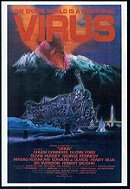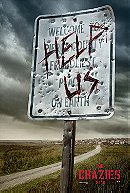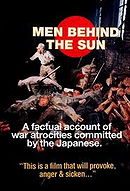Sort by:
Showing 9 items
Decade:
Rating:
List Type:
 Add items to section
Add items to section
Movies
The Crazies (1973)
The Crazies (1973), a US Army plane carrying an untested bio-weapon (a virus code-named "Trixie") crashes near a small Pennsylvania town contaminating the water; infected victims either die or become violently homicidal; heavily armed U.S. troops in NBC suits and gas masks, soon arrive
Virus - Day of Resurrection (1980)
Virus (1980) – in this Japanese movie, a deadly virus ("MM88") has been created accidentally by an American geneticist; it amplifies the potency of any other virus or bacterium it comes into contact with; in 1982, MM88 has been stolen from a lab in the US and a team of Americans vie with a shady East German scientist to recover it, but fail and a pandemic, initially known as the "Italian Flu", is the result.
Although the microbial threat in this science fiction film is a natural one returning to earth with a satellite, the scientific response team comes across germ warfare simulations, strongly indicating that the responsible US government projects were designed to actively search for harmful bio-agents for use in BW.
In The Crazies (2010 remake of 1973 film), the water in a small Iowa town becomes contaminated with "Trixie" — a "Rhabdoviridae prototype" bio-weapon — after a military cargo plane en route to an incinerator in Texas crashes; infected victims become cold, calculating, depraved, and bloodthirsty killers.
Nusch 's rating:


Philosophy of a Knife (2008), a Russian-American horror film covering the Japanese Army's Unit 731, mixing archival footage, interviews, and extremely graphic reenactments of the vile experiments performed there during WWII.
On Her Majesty's Secret Service (1969): in this James Bond film, women are being brainwashed by the villain to disseminate bio-warfare agents throughout the world.
The Satan Bug (1965)
The Satan Bug (1965), at "Station Three" — a top-secret US bioweapons lab in the Southern California desert — the protagonist investigates the murder of the security chief and disappearance of the director and head scientist; two lethal bioweapons — a strain of "botulinus" and a recently developed virus (the "Satan Bug") which could wipe out the earth's population in months — are missing.
The Omega Man (1971)
The Omega Man (1971), a science fiction film starring Charlton Heston; in 1975, BW between China and Russia kills most of the world's population. The protagonist, a U.S. Army scientist/physician, renders himself immune with an experimental vaccine. (In the source novel, I Am Legend (1954) by Richard Matheson, the plague is coincident with a great war, but it is not clear that it originated with BW.)
 Add items to section
Add items to section
Biological weapons
Biological warfare (BW)—also known as germ warfare—is the use of biological toxins or infectious agents such as bacteria, viruses, and fungi with the intent to kill or incapacitate humans, animals or plants as an act of war. Biological weapons (often termed "bio-weapons", "biological threat agents", or "bio-agents") are living organisms or replicating entities (viruses, which are not universally considered "alive") that reproduce or replicate within their host victims. Entomological (insect) warfare is also considered a type of biological weapon.
Smallpox
Smallpox was an infectious disease caused by either of two virus variants, Variola major and Variola minor. The disease is also known by the Latin names Variola or Variola vera, derived from varius ("spotted") or varus ("pimple"). The disease was originally known in English as the "pox" or "red plague";the term "smallpox" was first used in Britain in the 15th century to distinguish variola from the "great pox" (syphilis). The last naturally occurring case of smallpox (Variola minor) was diagnosed on 26 October 1977.
Infection with smallpox is focused in small blood vessels of the skin and in the mouth and throat before disseminating. In the skin it results in a characteristic maculopapular rash and, later, raised fluid-filled blisters. V. major produced a more serious disease and had an overall mortality rate of 30–35 percent. V. minor caused a milder form of disease which killed about 1 percent of its victims. Long-term complications of V. major infection included characteristic scars, commonly on the face, which occur in 65–85 percent of survivors. Blindness resulting from corneal ulceration and scarring, and limb deformities due to arthritis and osteomyelitis were less common complications, seen in about 2–5 percent of cases.
Smallpox is believed to have emerged in human populations about 10,000 BC. The earliest physical evidence of it is probably the pustular rash on the mummified body of Pharaoh Ramses V of Egypt. The disease killed an estimated 400,000 Europeans annually during the closing years of the 18th century (including five reigning monarchs), and was responsible for a third of all blindness. Of all those infected, 20–60 percent—and over 80 percent of infected children—died from the disease. Smallpox was responsible for an estimated 300–500 million deaths during the 20th century. As recently as 1967, the World Health Organization (WHO) estimated that 15 million people contracted the disease and that two million died in that year.
After vaccination campaigns throughout the 19th and 20th centuries, the WHO certified the global eradication of smallpox in 1979.
If we dive into the history, we can see that the United States Army began germ warfare research in 1942 as a response to intelligence about similar programs in Berlin and Tokyo. In 1956, the US government found out about existence of the Soviet bioweapons program, which resulted in the shift of emphasis from bacterial to viral pathogens.
In 1969, presiding president of the United States Richard Nixon ended America’s biological warfare program. His administration led the world in advocating the first multilateral disarmament treaty in 1972, which banned possession of such agents except for research into vaccines and treatments.
But when the World Health Organization (WHO) declared a global eradication of smallpox in 1980, Soviet officials recognized the potential of this agent as an exceptional biological weapon. The American government was unaware of the tremendous scale on which the Soviet government pursued its bioweapons operations until October 1989.
Hence US warfare projects began once again 10 years after the Soviet Union’s and on a much smaller scale. At its peak production level, the Soviet Union annually produced 100 metric tons of variola virus.
In conclusion, despite the promise of variola virus’s extinction as a biological entity, the outlook of clandestine weaponization of smallpox remains worrisome, and vaccination of military personnel could be seen as a defensive stance implying willingness to use variola virus as a weapon.

Botulinum
Botulinum toxin (BTX) is a neurotoxic protein produced by the bacterium Clostridium botulinum and related species. It is also produced commercially for medical, cosmetic, and research use. There are two main commercial types: botulinum toxin type A and botulinum toxin type B.
Infection with the bacterium may result in a potentially fatal disease called botulism. Botulinum is the most acutely lethal toxin known, with an estimated human median lethal dose (LD50) of 1.3–2.1 ng/kg intravenously or intramuscularly and 10–13 ng/kg when inhaled.
Botulinum toxin types A and B are used in medicine for, among others, upper motor neuron syndrome, focal hyperhidrosis, blepharospasm, strabismus, chronic migraine and bruxism. It is also widely used in cosmetic treatments. The U.S. Food and Drug Administration requires a boxed warning stating that when locally administered the toxin may spread from the injection site to other areas of the body, causing botulism. The warning was the result of deaths associated with its uses.
With the outbreak of World War II, weaponization of botulinum toxin was investigated at Fort Detrick in Maryland. Carl Lamanna and James Duff developed the concentration and crystallization techniques that Edward J. Schantz used to create the first clinical product. When the Army’s Chemical Corps was disbanded, Schantz moved to the Food Research Institute in Wisconsin, where he manufactured toxin for experimental use and generously provided it to the academic community.
The mechanism of botulinum toxin action – blocking the release from nerve endings of the neurotransmitter acetylcholine – was elucidated in the mid-1900s,and remains an important research topic. Nearly all toxin treatments are based on this effect in various body tissues.
The U.S. and Russia gave up trying to utilize botulinum because it could not be effectively "weaponized" like anthrax and smallpox. Weaponizing a bio-agent is a complex, multi-stage process. The final stage of weaponizing entails binding the bacteria to ultra-finely powdered materials like bentonite or silica gel. This allows the material to stay suspended, forming a stable aerosol vehicle for dissemination.7 However, studies done by the U.S. military indicate that a point-source aerosol release of weaponized botulinum toxin could incapacitate or even kill 10% of the people downwind for a distance of one-third of a mile (1.760 feet).7 Such a release in a subway, shopping mall or a large enclosed event like a basketball game would have a major impact on a city, especially if multiple releases occurred at different locations simultaneously.

Ebola
Ebola virus disease (EVD), also known as Ebola hemorrhagic fever (EHF) or simply Ebola, is a viral hemorrhagic fever of humans and other primates caused by ebolaviruses. Signs and symptoms typically start between two days and three weeks after contracting the virus with a fever, sore throat, muscular pain, and headaches. Then, vomiting, diarrhea and rash usually follow, along with decreased function of the liver and kidneys. At this time some people begin to bleed both internally and externally. The disease has a high risk of death, killing between 25 and 90 percent of those infected, with an average of about 50 percent. This is often due to low blood pressure from fluid loss, and typically follows six to sixteen days after symptoms appear.
The virus spreads by direct contact with body fluids, such as blood, of an infected human or other animals. This may also occur through contact with an item recently contaminated with bodily fluids.[1] Spread of the disease through the air between primates, including humans, has not been documented in either laboratory or natural conditions. Semen or breast milk of a person after recovery from EVD may carry the virus for several weeks to months.Fruit bats are believed to be the normal carrier in nature, able to spread the virus without being affected by it. Other diseases such as malaria, cholera, typhoid fever, meningitis and other viral hemorrhagic fevers may resemble EVD. Blood samples are tested for viral RNA, viral antibodies or for the virus itself to confirm the diagnosis.
As a biological weapons agent, the Ebola virus is feared for its high case-fatality rate. Because of its rarity, the disease may not be diagnosed corrected at the onset of an outbreak. Reports suggested that the Ebola virus was researched and weaponized by the former Soviet Union's biological weapons program Biopreparat. Dr. Ken Alibek, former the First Deputy Director of Biopreparat, speculated that the Russians had aerosolized the Ebola virus for dissemination as a biological weapon. The Japanese terrorist group Aum Shinrikyo reportedly sent members to Zaire during an outbreak to harvest the virus.

Bubonic plague
Bubonic plague is one of three types of bacterial infection caused by Yersinia pestis. Three to seven days after exposure to the bacteria flu like symptoms develop. This includes fever, headaches, and vomiting. Swollen and painful lymph nodes occur in the area closest to where the bacteria entered the skin. Occasionally the swollen lymph nodes may break open.
The three types of plague are the result of the route of infection: bubonic plague, septicemic plague, and pneumonic plague. Bubonic plague is mainly spread by infected fleas from small animals. It may also result from exposure to the body fluids from a dead plague infected animal. In the bubonic form of plague, the bacteria enter through the skin through a flea bite and travel via the lymphatic vessels to a lymph node, causing it to swell. Diagnosis is by finding the bacteria in the blood, sputum, or fluid from lymph nodes.
Prevention is through public health measures such as not handling dead animals in areas where plague is common. Vaccines have not been found to be very useful for plague prevention.Several antibiotics are effective for treatment including streptomycin, gentamicin, and doxycycline. Without treatment it results in the death of 30% to 90% of those infected. Death if it occurs is typically within ten days. With treatment the risk of death is around 10%. Globally in 2013 there were about 750 documented cases which resulted in 126 deaths. The disease is most common in Africa.
Plague is believed to be the cause of the Black Death that swept through Asia, Europe, and Africa in the 14th century and killed an estimated 50 million people. This was about 25% to 60% of the European population. Because the plague killed so many of the working population, wages rose due to the demand for labor. Some historians see this as a turning point in European economic development.The term bubonic plague is derived from the Greek word βουβών, meaning "groin". The term "buboes" is also used to refer to the swollen lymph nodes.
Some of the earliest instances of biological warfare were said to have been products of the plague, as armies of the 14th century were recorded catapulting diseased corpses over the walls of towns and villages to spread the pestilence.
Later, plague was used during the Second Sino-Japanese War as a bacteriological weapon by the Imperial Japanese Army. These weapons were provided by Shirō Ishii‘s units and used in experiments on humans before being used on the field. For example, in 1940, the Imperial Japanese Army Air Service bombedNingbo with fleas carrying the bubonic plague. During the Khabarovsk War Crime Trials, the accused, such as Major General Kiyashi Kawashima, testified that, in 1941, some 40 members of Unit 731 air-dropped plague-contaminated fleas on Changde. These operations caused epidemic plague outbreaks.

Anthrax
Anthrax is a naturally occurring disease of plant eating animals (goats, sheep, cattle, wine, etc.) caused by the bacterium Bacillus anthracis.
It is an illness which has been recognized since antiquity.
It can occur in four forms: skin, inhalation, intestinal, and injection. Symptoms begin between one day and two months after contracting the infection. The skin form presents with a small blister with surrounding swelling that often turns into a painless ulcer with a black center. The inhalation form presents with fever, chest pain, and shortness of breath. The intestinal form presents with nausea, vomiting, diarrhea, or abdominal pain. The injection form presents with fever and an abscess at the site of drug injection.
Anthrax is spread by contact with the spores of the bacteria, which are often from infectious animal products. Contact is by breathing, eating, or through an area of broken skin. It does not typically spread directly between people. Risk factors include people who work with animals or animal products, travelers, postal workers, and military personnel. Diagnosis can be confirmed based on finding antibodies or the toxin in the blood or by culture of a sample from the infected site.
Anthrax can be created easily in a lab, and is incredibly durable: Spores of anthrax bacteria can lie dormant for years before entering a living host, where they reactivate and multiply. These characteristics make anthrax an extremely dangerous bioterrorism weapon.
Anthrax has been used in bioterrorism and warfare since World War I, when Scandinavia deployed anthrax against the Imperial Russian Army. It was also used by the British army during World War II to weaken German livestock.
More recently, anthrax has been used in bioterrorism attacks in both Japan and the United States. In 1993, a religious cult in Japan deployed anthrax against civilians in Tokyo, but the attack yielded no injuries or fatalities.
In 2001, letters containing anthrax spores were mailed to several news-media offices and two U.S. senators, resulting in the deaths of five people and the infection of 17 others.

Smallpox
Smallpox was an infectious disease caused by either of two virus variants, Variola major and Variola minor. The disease is also known by the Latin names Variola or Variola vera, derived from varius ("spotted") or varus ("pimple"). The disease was originally known in English as the "pox" or "red plague";the term "smallpox" was first used in Britain in the 15th century to distinguish variola from the "great pox" (syphilis). The last naturally occurring case of smallpox (Variola minor) was diagnosed on 26 October 1977.
Infection with smallpox is focused in small blood vessels of the skin and in the mouth and throat before disseminating. In the skin it results in a characteristic maculopapular rash and, later, raised fluid-filled blisters. V. major produced a more serious disease and had an overall mortality rate of 30–35 percent. V. minor caused a milder form of disease which killed about 1 percent of its victims. Long-term complications of V. major infection included characteristic scars, commonly on the face, which occur in 65–85 percent of survivors. Blindness resulting from corneal ulceration and scarring, and limb deformities due to arthritis and osteomyelitis were less common complications, seen in about 2–5 percent of cases.
Smallpox is believed to have emerged in human populations about 10,000 BC. The earliest physical evidence of it is probably the pustular rash on the mummified body of Pharaoh Ramses V of Egypt. The disease killed an estimated 400,000 Europeans annually during the closing years of the 18th century (including five reigning monarchs), and was responsible for a third of all blindness. Of all those infected, 20–60 percent—and over 80 percent of infected children—died from the disease. Smallpox was responsible for an estimated 300–500 million deaths during the 20th century. As recently as 1967, the World Health Organization (WHO) estimated that 15 million people contracted the disease and that two million died in that year.
After vaccination campaigns throughout the 19th and 20th centuries, the WHO certified the global eradication of smallpox in 1979.
If we dive into the history, we can see that the United States Army began germ warfare research in 1942 as a response to intelligence about similar programs in Berlin and Tokyo. In 1956, the US government found out about existence of the Soviet bioweapons program, which resulted in the shift of emphasis from bacterial to viral pathogens.
In 1969, presiding president of the United States Richard Nixon ended America’s biological warfare program. His administration led the world in advocating the first multilateral disarmament treaty in 1972, which banned possession of such agents except for research into vaccines and treatments.
But when the World Health Organization (WHO) declared a global eradication of smallpox in 1980, Soviet officials recognized the potential of this agent as an exceptional biological weapon. The American government was unaware of the tremendous scale on which the Soviet government pursued its bioweapons operations until October 1989.
Hence US warfare projects began once again 10 years after the Soviet Union’s and on a much smaller scale. At its peak production level, the Soviet Union annually produced 100 metric tons of variola virus.
In conclusion, despite the promise of variola virus’s extinction as a biological entity, the outlook of clandestine weaponization of smallpox remains worrisome, and vaccination of military personnel could be seen as a defensive stance implying willingness to use variola virus as a weapon.

Botulinum
Botulinum toxin (BTX) is a neurotoxic protein produced by the bacterium Clostridium botulinum and related species. It is also produced commercially for medical, cosmetic, and research use. There are two main commercial types: botulinum toxin type A and botulinum toxin type B.
Infection with the bacterium may result in a potentially fatal disease called botulism. Botulinum is the most acutely lethal toxin known, with an estimated human median lethal dose (LD50) of 1.3–2.1 ng/kg intravenously or intramuscularly and 10–13 ng/kg when inhaled.
Botulinum toxin types A and B are used in medicine for, among others, upper motor neuron syndrome, focal hyperhidrosis, blepharospasm, strabismus, chronic migraine and bruxism. It is also widely used in cosmetic treatments. The U.S. Food and Drug Administration requires a boxed warning stating that when locally administered the toxin may spread from the injection site to other areas of the body, causing botulism. The warning was the result of deaths associated with its uses.
With the outbreak of World War II, weaponization of botulinum toxin was investigated at Fort Detrick in Maryland. Carl Lamanna and James Duff developed the concentration and crystallization techniques that Edward J. Schantz used to create the first clinical product. When the Army’s Chemical Corps was disbanded, Schantz moved to the Food Research Institute in Wisconsin, where he manufactured toxin for experimental use and generously provided it to the academic community.
The mechanism of botulinum toxin action – blocking the release from nerve endings of the neurotransmitter acetylcholine – was elucidated in the mid-1900s,and remains an important research topic. Nearly all toxin treatments are based on this effect in various body tissues.
The U.S. and Russia gave up trying to utilize botulinum because it could not be effectively "weaponized" like anthrax and smallpox. Weaponizing a bio-agent is a complex, multi-stage process. The final stage of weaponizing entails binding the bacteria to ultra-finely powdered materials like bentonite or silica gel. This allows the material to stay suspended, forming a stable aerosol vehicle for dissemination.7 However, studies done by the U.S. military indicate that a point-source aerosol release of weaponized botulinum toxin could incapacitate or even kill 10% of the people downwind for a distance of one-third of a mile (1.760 feet).7 Such a release in a subway, shopping mall or a large enclosed event like a basketball game would have a major impact on a city, especially if multiple releases occurred at different locations simultaneously.

Ebola
Ebola virus disease (EVD), also known as Ebola hemorrhagic fever (EHF) or simply Ebola, is a viral hemorrhagic fever of humans and other primates caused by ebolaviruses. Signs and symptoms typically start between two days and three weeks after contracting the virus with a fever, sore throat, muscular pain, and headaches. Then, vomiting, diarrhea and rash usually follow, along with decreased function of the liver and kidneys. At this time some people begin to bleed both internally and externally. The disease has a high risk of death, killing between 25 and 90 percent of those infected, with an average of about 50 percent. This is often due to low blood pressure from fluid loss, and typically follows six to sixteen days after symptoms appear.
The virus spreads by direct contact with body fluids, such as blood, of an infected human or other animals. This may also occur through contact with an item recently contaminated with bodily fluids.[1] Spread of the disease through the air between primates, including humans, has not been documented in either laboratory or natural conditions. Semen or breast milk of a person after recovery from EVD may carry the virus for several weeks to months.Fruit bats are believed to be the normal carrier in nature, able to spread the virus without being affected by it. Other diseases such as malaria, cholera, typhoid fever, meningitis and other viral hemorrhagic fevers may resemble EVD. Blood samples are tested for viral RNA, viral antibodies or for the virus itself to confirm the diagnosis.
As a biological weapons agent, the Ebola virus is feared for its high case-fatality rate. Because of its rarity, the disease may not be diagnosed corrected at the onset of an outbreak. Reports suggested that the Ebola virus was researched and weaponized by the former Soviet Union's biological weapons program Biopreparat. Dr. Ken Alibek, former the First Deputy Director of Biopreparat, speculated that the Russians had aerosolized the Ebola virus for dissemination as a biological weapon. The Japanese terrorist group Aum Shinrikyo reportedly sent members to Zaire during an outbreak to harvest the virus.

Bubonic plague
Bubonic plague is one of three types of bacterial infection caused by Yersinia pestis. Three to seven days after exposure to the bacteria flu like symptoms develop. This includes fever, headaches, and vomiting. Swollen and painful lymph nodes occur in the area closest to where the bacteria entered the skin. Occasionally the swollen lymph nodes may break open.
The three types of plague are the result of the route of infection: bubonic plague, septicemic plague, and pneumonic plague. Bubonic plague is mainly spread by infected fleas from small animals. It may also result from exposure to the body fluids from a dead plague infected animal. In the bubonic form of plague, the bacteria enter through the skin through a flea bite and travel via the lymphatic vessels to a lymph node, causing it to swell. Diagnosis is by finding the bacteria in the blood, sputum, or fluid from lymph nodes.
Prevention is through public health measures such as not handling dead animals in areas where plague is common. Vaccines have not been found to be very useful for plague prevention.Several antibiotics are effective for treatment including streptomycin, gentamicin, and doxycycline. Without treatment it results in the death of 30% to 90% of those infected. Death if it occurs is typically within ten days. With treatment the risk of death is around 10%. Globally in 2013 there were about 750 documented cases which resulted in 126 deaths. The disease is most common in Africa.
Plague is believed to be the cause of the Black Death that swept through Asia, Europe, and Africa in the 14th century and killed an estimated 50 million people. This was about 25% to 60% of the European population. Because the plague killed so many of the working population, wages rose due to the demand for labor. Some historians see this as a turning point in European economic development.The term bubonic plague is derived from the Greek word βουβών, meaning "groin". The term "buboes" is also used to refer to the swollen lymph nodes.
Some of the earliest instances of biological warfare were said to have been products of the plague, as armies of the 14th century were recorded catapulting diseased corpses over the walls of towns and villages to spread the pestilence.
Later, plague was used during the Second Sino-Japanese War as a bacteriological weapon by the Imperial Japanese Army. These weapons were provided by Shirō Ishii‘s units and used in experiments on humans before being used on the field. For example, in 1940, the Imperial Japanese Army Air Service bombedNingbo with fleas carrying the bubonic plague. During the Khabarovsk War Crime Trials, the accused, such as Major General Kiyashi Kawashima, testified that, in 1941, some 40 members of Unit 731 air-dropped plague-contaminated fleas on Changde. These operations caused epidemic plague outbreaks.

Anthrax
Anthrax is a naturally occurring disease of plant eating animals (goats, sheep, cattle, wine, etc.) caused by the bacterium Bacillus anthracis.
It is an illness which has been recognized since antiquity.
It can occur in four forms: skin, inhalation, intestinal, and injection. Symptoms begin between one day and two months after contracting the infection. The skin form presents with a small blister with surrounding swelling that often turns into a painless ulcer with a black center. The inhalation form presents with fever, chest pain, and shortness of breath. The intestinal form presents with nausea, vomiting, diarrhea, or abdominal pain. The injection form presents with fever and an abscess at the site of drug injection.
Anthrax is spread by contact with the spores of the bacteria, which are often from infectious animal products. Contact is by breathing, eating, or through an area of broken skin. It does not typically spread directly between people. Risk factors include people who work with animals or animal products, travelers, postal workers, and military personnel. Diagnosis can be confirmed based on finding antibodies or the toxin in the blood or by culture of a sample from the infected site.
Anthrax can be created easily in a lab, and is incredibly durable: Spores of anthrax bacteria can lie dormant for years before entering a living host, where they reactivate and multiply. These characteristics make anthrax an extremely dangerous bioterrorism weapon.
Anthrax has been used in bioterrorism and warfare since World War I, when Scandinavia deployed anthrax against the Imperial Russian Army. It was also used by the British army during World War II to weaken German livestock.
More recently, anthrax has been used in bioterrorism attacks in both Japan and the United States. In 1993, a religious cult in Japan deployed anthrax against civilians in Tokyo, but the attack yielded no injuries or fatalities.
In 2001, letters containing anthrax spores were mailed to several news-media offices and two U.S. senators, resulting in the deaths of five people and the infection of 17 others.

Hong Kong–Chinese historical war horror film graphically depicting war atrocities at Unit 731, a secret Japanese BW facility, during World War II; details the various cruel medical experiments inflicted upon Chinese and Soviet POWs.
 Login
Login
 256
256
 6.5
6.5
 6.1
6.1







